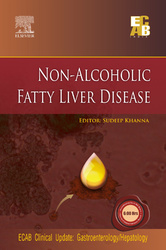「重要なお知らせ:日本語書籍をご購入いただき、eLibraryをご利用の皆さまへ」
エルゼビアは、より快適にサービスをご利用いただくため、システムの重要なアップデートを実施いたします。
現在、新サイト、eBooks+への移行が進められています。
新規ユーザー登録および書籍の登録はElsevier eLibraryでは停止しております。
12月15日以降に
こちらよりご利用・ご登録ください。
Book Description
Non-alcoholic fatty liver disease is a common cause of chronic liver disease, and its incidence is rising worldwide. Understanding its pathogenesis, biochemical parameters, histological grading and staging, and its management is a vital issue in today’s clinical practice. It appears to be linked directly to the growing epidemic of obesity in adults as well as in children. Thus, in a sense, NAFLD is a self-inflicted liver disease, much like alcoholic liver disease. The exact causes responsible for the development of NAFLD have not been established yet. However, some researchers consider that cluster of disorders that increases the risk of developing heart disease, diabetes, and stroke may be the factor behind development of NAFLD.
Most patients with NAFLD have no symptoms or signs of liver disease at the time of diagnosis. In these patients, abnormal liver function tests are often discovered incidentally. Non-alcoholic steatohepatitis (NASH) is that stage of the spectrum that involves fat accumulation (steatosis), inflammation (hepatitis), and scarring (fibrosis) in the liver. Those who have fatty liver or hepatic steatosis with non-specific inflammation as fatty liver with non-specific inflammation generally have a benign longterm prognosis, whereas those who have NASH can progress to cirrhosis. NASH-related cirrhosis may have similar prognosis as cirrhosis from other causes. Hepatocellular carcinoma (HCC) is part of the spectrum of NAFLD, and screening for HCC seems reasonable in patients who have NASH-related cirrhosis. No established treatment is available for NAFLD. Some empiric treatment strategies have been suggested. Presumably, weight loss through exercise and diet modification along with insulinsensitizing agents will help reverse fatty infiltration of the liver. Its incidence is reportedly on the rise the world over as well as in India. Realizing its significance, there is now greater understanding of its etiology, pathogenesis, and management. The efforts of Elsevier have been directed toward addressing these aspects.
Elsevier has thus pooled its existing resources with those of the internationally acclaimed Gastroenterologists of India who have chosen to share their rich clinical knowledge, experience, and expertize to serve the practitioners and patient community.


 (0 rating)
(0 rating) 





